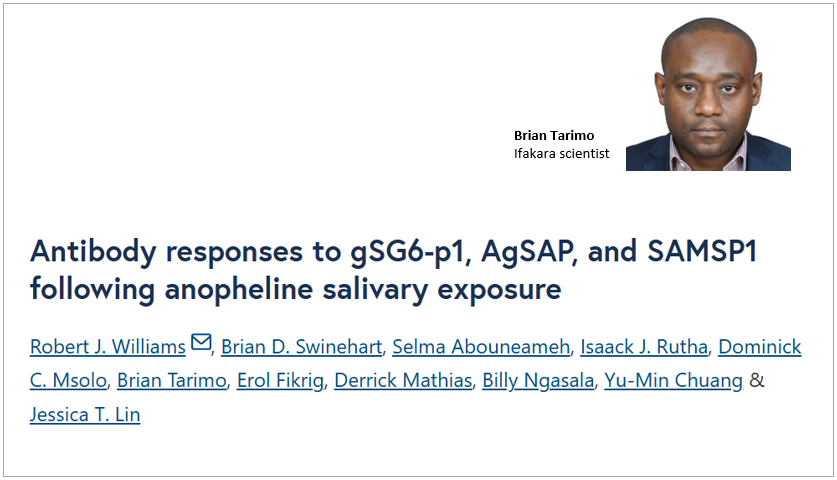
THIS IS NEW! Mosquito saliva could track malaria exposure

Scientists from Tanzania and the USA have found that mosquito saliva could offer a powerful new way to track malaria exposure in people.
In a new study published recently on Parasites & Vectors, they report that certain proteins in the saliva of Anopheles mosquitoes – the species that spreads malaria – can show recent exposure to mosquito bites. This makes mosquito saliva a promising tool for improving malaria surveillance.
Mosquito saliva as a “biomaker” for exposure
When a mosquito bites, it injects saliva into the skin to prevent the blood from clotting and make feeding easier. This saliva contains special proteins known as mosquito salivary antigens (MSAs) such as Anopheles gambiae sporozoite-associated protein (AgSAP) and sporozoite-associated mosquito salivary protein 1 (SAMSP1).
The human immune system reacts to these proteins by producing antibodies. By measuring these antibodies in a blood sample, researchers can estimate how recently a person has been bitten by malaria-carrying mosquitoes.
This makes mosquito saliva a potential biomarker for exposure to infectious mosquito bites and estimating malaria transmission more accurately — especially in areas with low transmission, and where traditional methods of measuring exposure to malaria-infected mosquitoes are often less effective or unreliable.
Why it matters
Malaria continues to kill more than half a million people every year, mostly from sub-Saharan Africa. As countries get closer to elimination, it becomes harder to detect the remaining areas where transmission is occurring.
If antibody responses to proteins like AgSAP and SAMSP1 can reliably indicate recent exposure to malaria-infected mosquito bites, they could become valuable tools for measuring how much malaria transmission is happening.
This study shows that AgSAP and SAMSP1 are promising biomarkers for exposure to Anopheles mosquito bites and could complement other serological tools used to estimate human contact with malaria vectors.
Inside the study
The study, was carried out by scientists from Tanzania – including the Ifakara Health Institute (IHI) and Muhimbili University of Health and Allied Sciences – together with researchers from the USA at Yale University, the University of North Carolina, and the University of Florida.
They focused on two mosquito salivary proteins – AgSAP and SAMSP1 – and compared them to gSG6-p1, a well-studied salivary protein already used to measure mosquito exposure.
“This study shows that AgSAP and SAMSP1 are promising indicators of exposure to Anopheles mosquito bites and could enhance existing tools for estimating human contact with malaria vectors,” the scientists noted but also emphasized the need for further research to understand how the antibody (IgG) responses to these proteins’ changes over time after mosquito bites.
Promising results from Tanzania
The study, carried out in Bagamoyo District, Tanzania, found that AgSAP, SAMSP1, and GSG6-p1 levels were all higher in people with low-density malaria infections — often showing mild or no symptoms. Increased reactivity for AgSAP and GSG6-p1 were also seen in the villages with higher malaria prevalence.
Meanwhile, SAMSP1 triggered stronger immune responses during the rainy season, when mosquito populations and malaria cases peak. Researchers believe this was because SAMSP1 is found in multiple species of Anopheles mosquitoes.
A new frontier for malaria control
While these findings are still in early stages, they offer a new perspective; the next breakthrough in malaria control may not come from killing mosquitoes – but from learning what their saliva reveals.
“Accurately estimating the risk of malaria transmission is essential for deploying and monitoring effective control, management, and elimination strategies,” the researchers emphasized. “The beauty of salivary biomarkers is that they can tell us who has been bitten and when, without needing to find the mosquito.”
For now, the scientists underline that more research is needed to determine how long antibody responses last and how accurately they reflect actual exposure.
Ifakara scientists’ contribution
Ifakara Health Institute scientists Isaack Rutha, Dominick Msolo, and Brian Tarimo contributed to the study by conducting mosquito feeding assays and collecting key data.
The research was co-led by Yu-Min Chuang of Yale University (USA) and Jessica Lin of the University of North Carolina School of Medicine (USA). Robert Williams, also from UNC, served as the corresponding author.
Read the publication, here.
